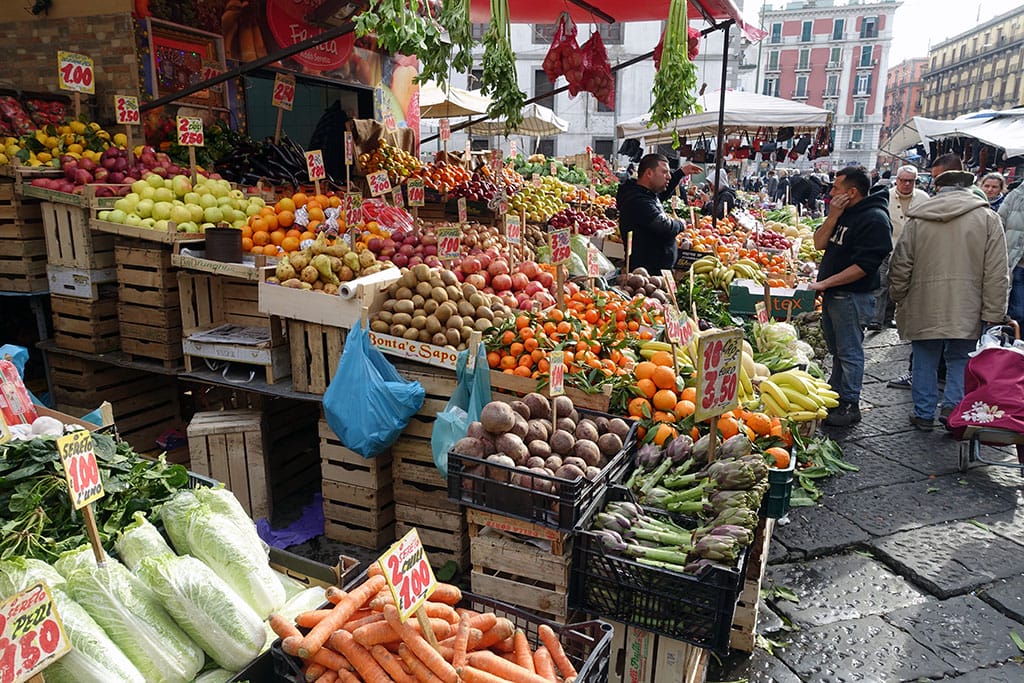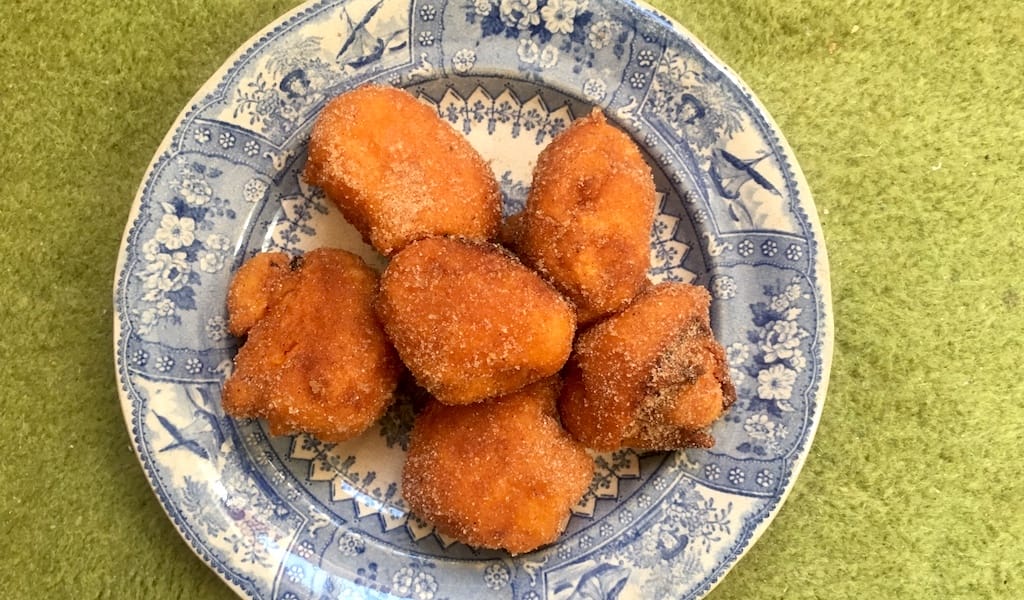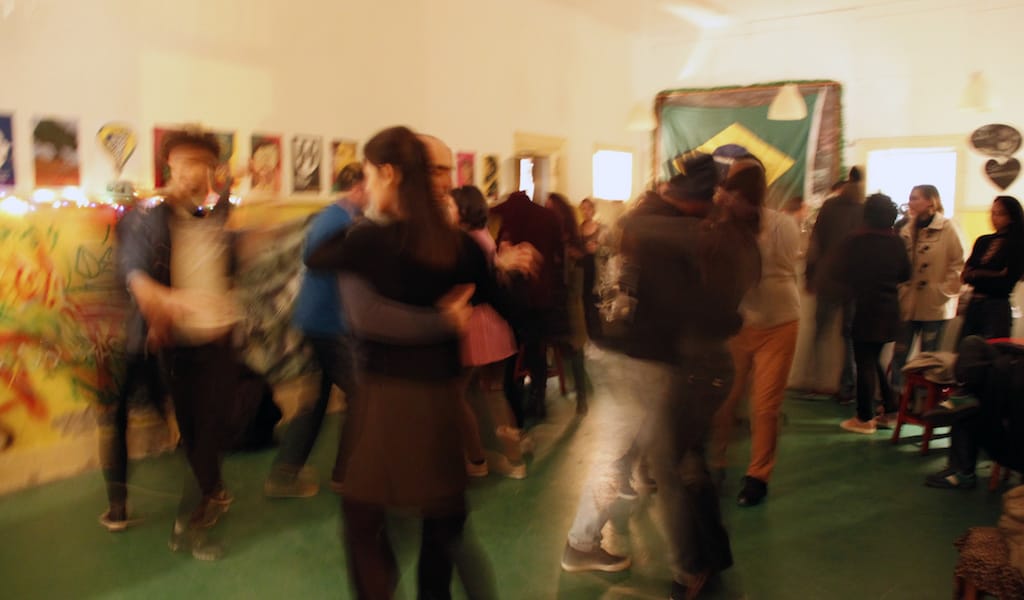While in many parts of Europe consumer capitalism has brought an invasion of chain supermarkets and restaurants, contributing to the extinction of independent family-run grocers, Naples and the small distinct districts of its old town have magically managed to resist.
The neighborhood markets retain a charm that is reminiscent of a by-gone era when Europe’s streets would smoke and hiss and the ground would be covered in cabbage crusts and fish entrails. The city’s cobbled and narrow streets revolve around civic life, which still brims with stalls selling fresh mollusks, sacks of nuts, knots of garlic and onions, rounds of cheese and hanging hams. Ragged trouser traders, howling hawkers and crooks cram into the alleyways where fruit and vegetable stands nestle alongside opportunistic vendors roasting a few foraged chestnuts or artichoke hearts from smoking iron vessels.
Naples’s chaotic energy has inspired and repulsed in equal measure the travelers that have passed through it. Walter Benjamin and Johann Wolfgang von Goethe both wrote extensively in praise of the city’s unappreciated qualities.
In Naples, the neighborhood is everything. The city is made up of villages – villages within villages.
The influential poet, novelist and filmmaker Pier Paolo Pasolini had a taste for Naples, too. He enjoyed precisely the lack of homogenized goods and chain stores popping up elsewhere. He opposed the rapid socio-economic changes taking place in Italy under the ruling Christian Democrat party in the decades after WWII and declared vehemently in what was to be his final interview, “I consider consumerism to be a worse form of fascism than the classic variety.” Pasolini’s political and social values, in awe of working class traditions, came under threat in the anni di piombo. In the “lead years,” the influence of Soviet ideology came into conflict with the Western agenda that promoted capitalist aspirations and a throwaway consumer culture. As Italy succumbed to change, Pasolini became a victim of the new order when he was brutally murdered in 1975.
This change in the socio-economic landscape took place in a country divided by considerable economic inequality and by an invisible north-south cultural border. Urban life in Milan was – and is – starkly different from the “making do” nature of Naples. Yet, throughout Italy, as Pasolini feared, desires were gradually manipulated and the once-common practices of families gathering to make tomato sauce, roll out sheets of pasta or harvest grapes at the vendemmia in the village square became looked down upon. In their place, bottled wines and oils, tinned tomatoes, packaged pasta, farmed cockles and shrink-wrapped hams boomed. They called it the “Economic Miracle.”
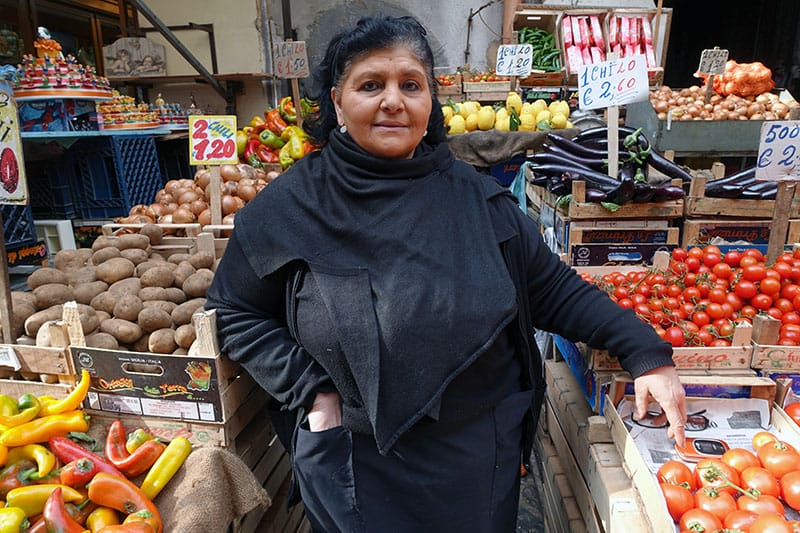
However, away from the industrial north in the poorer south, collective farming and laborious cooking methods were still ubiquitous. This meant slower uptake of the new regime, which Pasolini greatly admired as a form of resistance. He described Naples as the “last great plebeian metropolis, the last great village in Italy,” imagining traditional modes of living as an intrinsically positive feature in daily life. Finally, someone had Naples on a pedestal – a rarity for a city plagued by a reputation of organized crime and rotting garbage.
And yet, resisting consumer culture is not all saintly. Pasolini’s poetic view of the city blindly ignored the suffering and poverty endured by Neapolitans over the decades due to the city’s inability to modernize and accommodate large business. However, Pasolini did identify in Naples a certain maverick quality which would allow the city to nurture and maintain its magnetically unmodern and ramshackle character.
The “primordial urbanism,” as described by Nick Dines in his ethnographic account of Naples titled Tuff City, attracted Pasolini more than 50 years ago and is the essence that is still somewhat alive in a new guise. Home baking and collective passata canning can still be found in Naples (to a much lesser degree, of course), and daily life continues to comprise a vibrant street culture with a vast quantity of independent, family-run food stores.
Traditions are still everything in Naples. The city prides itself on San Marzano tomatoes, which are grown nearby and are considered by many to be the best in the world, as well as the finest Lacryma Christi vines, ripened by stroking sea winds and the sun beating down on Vesuvius. The region produces the creamiest buffalo mozzarella in the world and grows its own indigenous broccoli, called friarelli. Cultivation methods are written into law to regulate producers, making it impossible to cut corners on quality. This abundance of produce then finds its way from fertile volcanic soil into the neighborhood markets, and locals take it home and cook it with care according to ancient recipes.
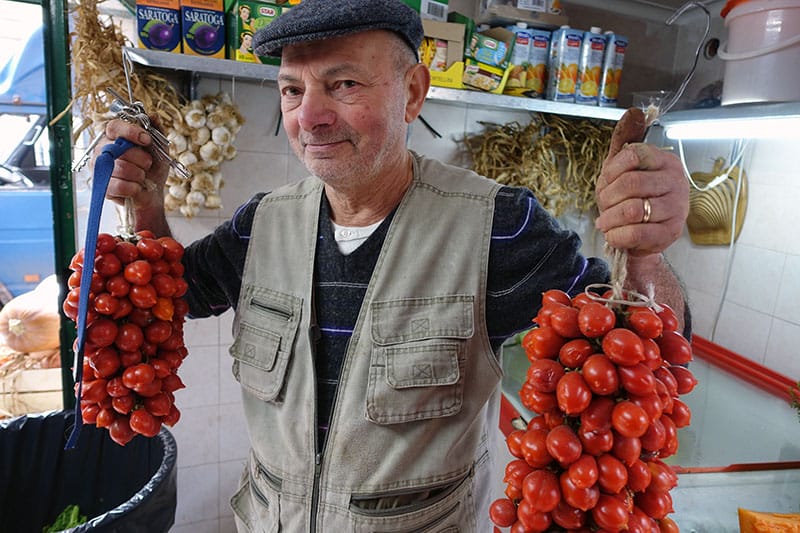
Today, Pasolini’s great Neapolitan village is beginning to thrive again after a period of depression, but local shopping customs are unchanged: the neighborhood is everything. The city is made up of villages – villages within villages. The city breaks down into concentric circles that decrease in size until you are left with little hamlets, each with their own grocer, fruit seller, fishmonger, butcher and baker. Along with the local stores each neighborhood has its own church, a couple of trattorie and a favored pizzeria where locals queue routinely each Saturday night. (The queue is a peculiar phenomenon to consider when across the road a forlorn and empty Pizzeria eagerly awaits the overflow.)
In fact, Neapolitans are creatures of habit. From the places they shop, the pizzeria they frequent and to the recipes they determinedly stick to, they don’t like change. It is worth, therefore, zooming in on specific hamlets and identifying the perfect places to buy produce because, after all, they are steeped in tradition, tried and tested and worth the queue.
Editor’s note: Traditionally we have published State of the Stomach pieces when beginning coverage of a new city, to provide an introduction to its food culture and how it shapes daily life. But as we dive deeper into the cities we work in, we’re taking stock of what’s changed, particularly as internal and external factors reshape both the culinary and urban landscape. As part of this reexamination, we thought it was worthwhile to republish our State of the Stomach for Naples, which first ran in March 2017.
 December 28, 2018 Sonhos
December 28, 2018 Sonhos
Whenever I hear Annie Lennox singing, “Sweet dreams are made of this, who am I to […] Posted in Lisbon December 15, 2021 Best Bites 2021
December 15, 2021 Best Bites 2021
For the first time in 14 years, I have not left China for an entire calendar year – […] Posted in Shanghai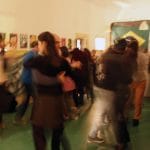 February 8, 2018 Brazil in Lisbon: Go Deep
February 8, 2018 Brazil in Lisbon: Go Deep
Among the many bars of raucous Bairro Alto, Casa do Brasil is a steadfast nighttime […] Posted in Lisbon
Published on February 19, 2018
Related stories
December 28, 2018
LisbonWhenever I hear Annie Lennox singing, “Sweet dreams are made of this, who am I to disagree,” I like to think she’s looking at a bowl of pumpkin doughnuts. I’m sure she never heard of sonhos, but let me explain. Traditionally, the Portuguese consume large amounts of sugar and cakes at Christmas time, from the…
December 15, 2021
ShanghaiFor the first time in 14 years, I have not left China for an entire calendar year – actually 620 days, but who’s counting? It’s a weird feeling, and one that makes me more than a little sad, so I’ve been trying to make up for it by eating delicious food as often as possible.…
February 8, 2018
LisbonAmong the many bars of raucous Bairro Alto, Casa do Brasil is a steadfast nighttime institution for Lisbon’s Brazilian community, hosting concerts and cultural events in a non-profit capacity. This two-floor venue is the place to chat, drink, eat and dance to a myriad popular rhythms from the homeland, all performed live: the festive accordion-drone…







































